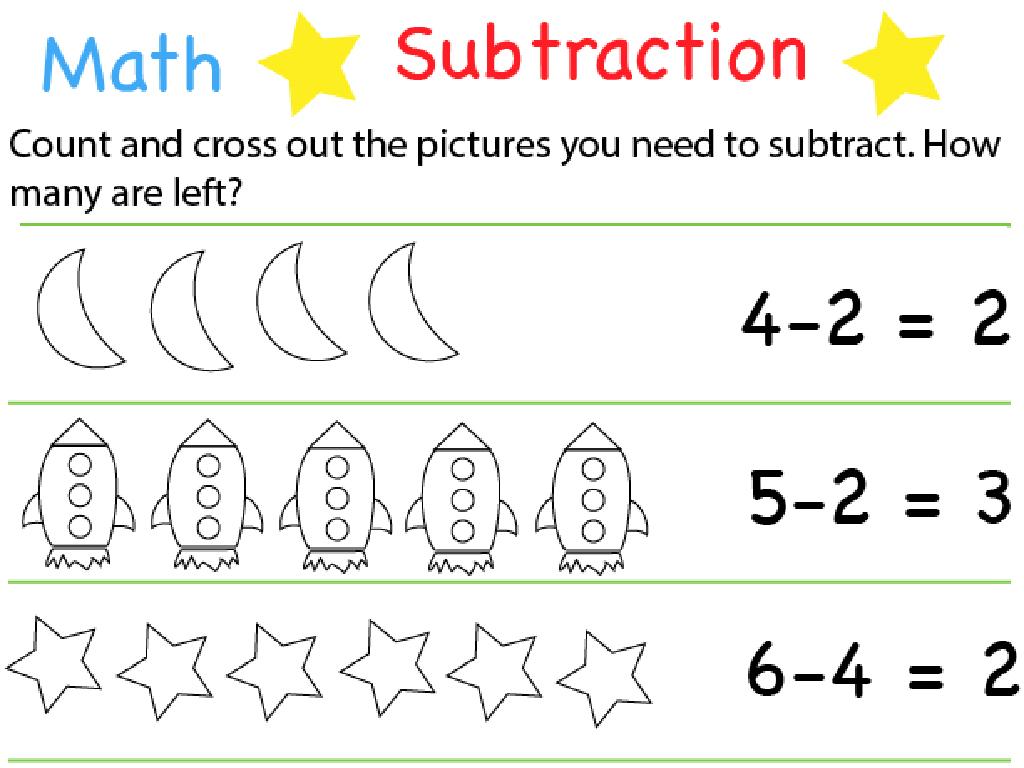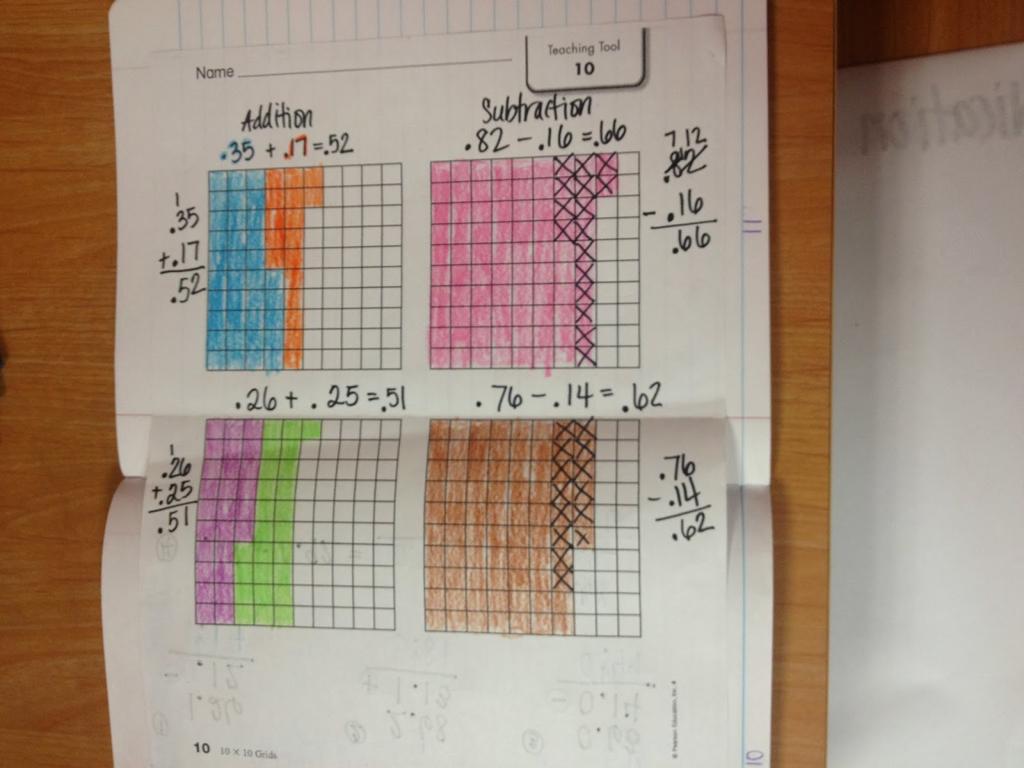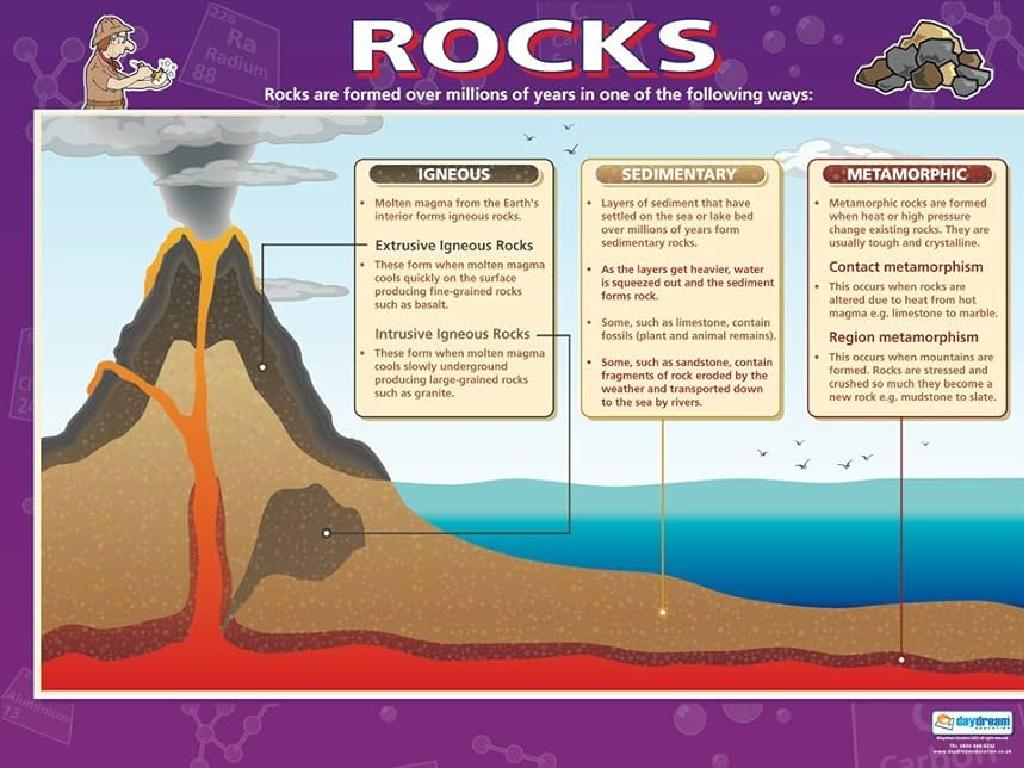Interpret Frequency Charts: One-Step Problems
Subject: Math
Grade: Fifth grade
Topic: Data And Graphs
Please LOG IN to download the presentation. Access is available to registered users only.
View More Content
Exploring Frequency Charts in Data and Graphs
– Data’s role in daily life
– Data helps us make decisions based on patterns
– Introduction to frequency charts
– A table that shows how often something occurs
– Reading frequency charts
– Learn to interpret data from charts
– Applying chart information
– Use chart data to solve one-step problems
|
This slide introduces the concept of frequency charts within the broader topic of data and graphs. Begin by discussing how data influences our everyday decisions, such as choosing what to wear based on weather patterns. Explain that a frequency chart is a tool for organizing data to show the number of times an event or category occurs. Emphasize the importance of being able to read and interpret these charts to extract meaningful information. Conclude by illustrating how students can apply the information from frequency charts to solve simple problems, reinforcing the practical application of this skill in real-life scenarios. Encourage students to think of examples where they encounter data and how it might be represented in a frequency chart.
Understanding Data in Our World
– Data: Collected information
– Data is gathered info for analysis, like survey results.
– Data examples in daily life
– Weather forecasts, sports scores, and class attendance.
– Data’s role in decision-making
– We use data to choose what to wear, who won a game, etc.
– Frequency charts as data tools
– Charts show how often something happens, like favorite ice cream flavors in class.
|
This slide introduces the concept of data to fifth-grade students, emphasizing its prevalence and importance in everyday life. Data is defined as collected information that can be used for analysis and decision-making. Provide relatable examples such as weather forecasts, which help us decide what to wear, or sports scores, which determine the winner of a game. Explain that data helps us make informed decisions by analyzing patterns and trends. Introduce frequency charts as a tool for organizing data, showing how often certain events occur, which will be explored further in the context of one-step problems. Encourage students to think of other examples of data in their lives and how it influences their choices.
Understanding Frequency Charts
– What is a frequency chart?
– A visual tool for counting occurrences
– Key components of charts
– Title for reference, Categories for grouping, Frequency for data count
– Significance of frequency charts
– They help us summarize and analyze data quickly
– Interpreting chart data
– Use chart info to solve one-step problems
|
This slide introduces frequency charts, a fundamental concept in data representation for fifth-grade math. Begin by explaining that a frequency chart is a way to show how often something happens, using a visual format that makes it easier to understand large amounts of data. Highlight the key parts of a frequency chart: the title, which tells us what the data is about; the categories, which group similar data; and the frequency, which shows how many times something occurs. Emphasize the importance of frequency charts in organizing and interpreting data, making it simpler to see patterns and draw conclusions. Conclude by showing how to read the chart to solve one-step problems, such as finding the most or least frequent category. Provide examples of frequency charts and encourage students to practice interpreting them with real-world data.
Reading Frequency Charts
– Identify chart title and subject
– What is the chart called and what information is it showing?
– Examine categories and frequencies
– Look at the different groups and how often they occur
– Interpret what the numbers indicate
– What can we learn from the frequency of these categories?
– Solve one-step problems
|
This slide is aimed at teaching students how to read and interpret frequency charts. Start by identifying the title of the chart to understand what information is being presented. Then, guide students to examine the categories listed on the chart and their corresponding frequencies, which show how often each category occurs. Discuss with students what the numbers on the chart tell us about the data. For example, which category is the most common or least common? Finally, use this information to solve one-step problems related to the data. Encourage students to ask questions about the chart and what they notice about the frequencies. This will help them become more comfortable with interpreting data and using it to solve problems.
Creating a Frequency Chart
– Collect data for the chart
– Gather information on a topic, like favorite fruits of classmates
– Organize data into categories
– Sort the data into groups, such as apples, bananas, oranges
– Count frequency for categories
– Tally how many times each fruit was chosen
– Visualize data with a chart
– Create a chart to display the collected data clearly
|
This slide is aimed at guiding students through the process of creating a frequency chart. Start by collecting data, which could be anything from favorite fruits to daily temperatures. Next, organize the data into clear categories. Then, count how many times each category occurs; this is the frequency. Finally, use the frequencies to create a visual chart, which makes the data easier to understand at a glance. Encourage students to think of their own examples and understand that frequency charts are a tool to summarize data in an easily interpretable way. This activity will help them develop skills in data collection, organization, and representation.
Interpreting Frequency Charts
– Understanding frequency charts
– A frequency chart shows how often something occurs
– Discovering data patterns
– Look for trends or repetitions in the chart
– Making predictions with data
– Use patterns to guess future occurrences
– Applying knowledge to problems
|
This slide introduces students to the concept of frequency charts and how to interpret them. A frequency chart is a visual representation of how often each value in a set of data occurs. It’s important for students to recognize patterns within these charts, such as which items occur most or least frequently. By identifying these patterns, students can make predictions about future data. For example, if a chart shows that a certain product sells most during a particular season, one can predict higher sales during that time in the future. Encourage students to practice with real-life examples, such as class survey results or daily temperature readings, to solidify their understanding. The final point on the slide prompts students to apply what they’ve learned to solve one-step problems involving frequency charts.
Solving One-Step Problems with Frequency Charts
– Use charts to solve problems
– Example: Favorite ice cream flavors
– How many chose chocolate from the chart?
– Class practice problem
– Find out how many prefer vanilla over chocolate
– Discuss solutions together
|
This slide introduces students to the practical application of frequency charts in solving one-step problems. Start by explaining how frequency charts can represent data in a visual format, making it easier to interpret information. Use an example like determining the number of students who prefer chocolate ice cream by looking at the chart. Then, present a practice problem for the class, such as comparing the number of students who prefer vanilla to those who prefer chocolate. Encourage students to participate in solving the problem and discuss the different approaches they take. This activity will help reinforce their understanding of data interpretation and enhance their problem-solving skills.
Let’s Practice Frequency Charts!
– Solve individual practice problems
– Pair up to tackle chart problems
– Work together to understand frequency charts better
– Discuss solutions with your partner
– Explain how you solved the problem to your partner
– Share findings with the class
– Be ready to present your method and answer to the class
|
This slide is designed for an interactive class activity focused on frequency charts. Students will start by working on individual problems to apply their knowledge of interpreting data. Then, they will pair up to solve additional problems, which encourages collaboration and peer learning. As they work in pairs, they should discuss their problem-solving strategies and clarify any doubts with each other. Finally, each pair will share their solutions and methods with the class, fostering a collaborative learning environment. The teacher should circulate the room, providing guidance and support as needed. Possible activities could include interpreting data from a chart about favorite school subjects, daily temperatures, or tallying the number of each type of pet owned by students in the class.
Class Activity: Create Your Frequency Chart!
– Collect class favorite fruits data
– Create a frequency chart
– Tally the fruits and plot on the chart
– Present and explain your chart
– Share what your chart indicates about class preferences
– Discuss findings with the class
– Engage with peers on their fruit choices and chart differences
|
This interactive class activity is designed to help students understand the concept of frequency charts by applying it to a fun and relatable topic: their favorite fruits. Students will first gather data by surveying their classmates’ favorite fruits. They will then use this data to create their own frequency charts, which will involve tallying the number of votes for each fruit and representing this visually. Once the charts are created, students will present their findings to the class, explaining what the chart shows about the class’s fruit preferences. This will help them practice interpreting data and speaking in front of a group. Finally, they will discuss their findings, comparing and contrasting the different charts. For the teacher, prepare a list of possible fruits to make data collection easier, ensure students understand how to tally and create a chart, and guide them on how to present data clearly.
Wrapping Up: Frequency Charts
– Key takeaways on frequency charts
– Significance of data interpretation
Data helps us make informed decisions in daily life.
– Open floor for questions
– Share interesting observations
Did you find any patterns or surprises in the charts?
|
As we conclude today’s lesson, we’ll review the main points about frequency charts. Emphasize how frequency charts help us organize data and the importance of being able to interpret these charts. Understanding data is crucial because it helps us make sense of information and make informed decisions. Encourage students to ask any lingering questions they might have or to share any interesting observations they made during the lesson. This will help ensure they have grasped the concept and can apply it to real-world scenarios. Additionally, ask them to think about how they can use frequency charts in their daily lives, such as keeping track of their habits or the weather.






